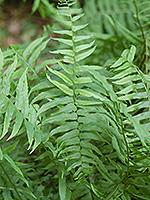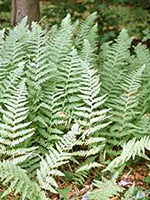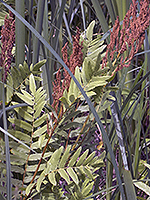
The Friends of the Wild Flower Garden
P. O. Box 3793
Minneapolis MN 55403
Planting of our native ferns
An article by Martha Crone
This article was written in 1957 by former Garden Curator Martha Crone. It stands the test of time. For images of all the ferns and links to information sheets about then go to our Fern Thumbnails Sheet.
Altho many of our native ferns are quite cosmopolitan, the successful cultivation of a goodly number depends largely upon simulation of natural environments. Pleasing results are easily obtained under seemingly adverse conditions. Given an eastern exposure and partial shade, the majority of our ferns flourish under cultivation. Many will grow on the north side of a house with fair results.
When ferns are once established they require little care, altho during extremely dry weather it is best to allow the hose to lie on the ground for the purpose of soaking. A full spray turned on them is very disastrous. For the average gardener with only a limited area there is more varied beauty and greater interest in a mixed border, perhaps massing several species.
The spring awakening of ferns is most interesting. They all come from the ground rolled up like a watch spring. A row of well-developed Ostrich Ferns following the foundation wall is most imposing. The plume-like fronds of this magnificent species sometimes reach a height of five feet when grown in moist areas. The fronds grow in circle, and bend outward in vase-like form, combining grace and dignity. In shaded situations a charming effect is produced by the Narrow-leaved Spleenwort. This clear-cut delicate fern makes a pretty addition to the wild garden, An exposed situation is not advised as the fronds are easily broken by wind.
Matteuccia struthiopteris

(Glade Fern)
Diplazium pycnocarpon

Dennstaedtia punctilobula
The Boulder or Hay-scented Fern in considered one of the most decorative. Growing as it does from an extensively creeping rootstock it is fine for massing. Goldie’s Fern is the most striking of the ferns that like to grow in moist rich soil or shaded slopes and has fronds that sometimes are 3 feet long and a foot wide and bright green in color. The Silvery Spleenwort does well in this locality altho often overlooked. Its silvery white fruit dots are its greatest beauty forming an interesting pattern on the underside of the fertile fronds.
The Marginal Shield Fern prefers a rocky dry woodland habitat, yet will grow in various situations. The blue-green color of this fern forms contrasting effects, especially with the lovely evergreen Christmas Fern which helps cheer the winter months.
Dryopteris goldiana
Deparia acrostichoides

Dryopteris marginalis
The Royal and Cinnamon Ferns are desirable in the composition of woodland and bog plantings and are easy to grow. The stately and handsome Cinnamon Fern will spread and form dense growths limited only by the boundaries of moist areas. Shade and abundant moisture are essential to luxuriant growth. The Interrupted Fern likes to wander up hillsides. It will flourish in any soil, even in open sun. It also does well in foundation plantings. The 3 to 5 feet tall fronds form a graceful fountain-like appearance. This large imposing fern is easily grown.

Osmunda regalis
Osmundastrum cinnamomeum

Dryopteris marginalis
The Lady Fern is an all around satisfactory fern to plant altho it is persistent and aggressive, often crowding out more delicate species. It loses its beauty much earlier in the season than many others. Maidenhair Fern, one of our best known and most distinctive ferns likes to grow in colonies in rich soil in shade or partial shade and combines well with many other varieties. This fern holds its freshness long after others have faded, even withstanding light frost.
It must be remembered that it takes some time for young plants to attain their full proportions.
Athyrium filix-femina

Adiantum pedatum
Photos are ©G D Bebeau except Hay Scented Fern which is courtesy of Emmett J. Judziewicz, Wisconsin Flora.
Reference: This article was published in the newsletter of the Friends of the Wild Flower Garden, Inc., the Fringed Gentian™, Vol. 5 No. 1, January 1957